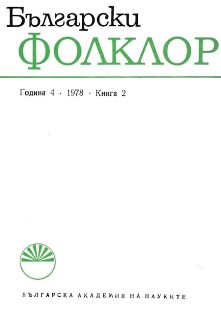Наблюдения върху отношенията между мотива и морфологическата функция в повествователния фолклор
Observations on Relations between Motif and Morphological Function in Narrative Folklore
Author(s): Lyubomira ParpulovaSubject(s): Anthropology
Published by: Институт за етнология и фолклористика с Етнографски музей при БАН
Summary/Abstract: Relationships between the morphological function, motif, motifeme and alomotif. A fairy tale is used as experimental material. The problems are considered on the level of structural and monotextual analysis. The term ‘morphological function’ is used with the content put into it by V. Propp, ‘motifeme’ and ‘alomotif’, according to the conceptions of A. Dundes, and ‘motif’, according to the author's ideas, set forth in her article On the Content of the Term Motif in Folklore. The concept of the of unity of morphological function and motifeme is foundalaying. The following types of relations are examined: A) Morphologically equivalent motifemes and alomotifs carry out the same functions in the course of the narrative action but have a different concrete content. B) Morphologically polyvalent motifemes and alomotifs: a. Analytical polyvalence – a motifeme depending on the concrete narrative action carries out different functions. b. Synthetic polyvalence – a motifeme in the course of the narrative action jointly performs several morphological functions. The semantic equivalence of motifemes and alomotifs, its role in varying the plots (creation of synonymous and antonymous motifeme constructions), the mechanism of transformations in creating semantic equivalent alomotifs are also subject of attention. A conclusion is drawn that morphologically equivalent motifemes are obligatorily also semantically equivalent, but the contrary is not obligatory. Relations between a motifeme, morphological function and constructive function (in the sense of the term in Tinyanov) are analyzed, and the conclusion is reached that the varieties of morphological function (auto-function and synfunction) are not related to morphological function, but to motifeme and alomotifs.
Journal: Български фолклор
- Issue Year: IV/1978
- Issue No: 2
- Page Range: 21-29
- Page Count: 9
- Language: Bulgarian
- Content File-PDF

